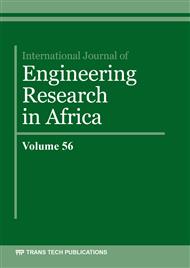[1]
V. Fiore, A. Valenza, and G. Di Bella, Mechanical behavior of carbon/flax hybrid composites for structural applications, J. Compos. Mater 46 (2012) 2089–(2096).
DOI: 10.1177/0021998311429884
Google Scholar
[2]
Q. Wang, W. Wu, Z. Gong, W. Li, Flexural progressive failure of carbon/glass interlayer and intralayer hybrid composites, Materials 11 (2018) 1–18.
DOI: 10.3390/ma11040619
Google Scholar
[3]
N. Guermazi, N. Haddar, K. Elleuch, H. F. Ayedi, Investigations on the fabrication and the characterization of glass/epoxy, carbon/epoxy and hybrid composites used in the reinforcement and the repair of aeronautic structures, Mater. Des. 56 (2014) 714–724.
DOI: 10.1016/j.matdes.2013.11.043
Google Scholar
[4]
Y. Swolfs, Perspective for fibre-hybrid composites in wind energy applications, Materials 10 (2017) 2–27.
Google Scholar
[5]
J. M. F. De Paiva, S. Mayer, M. C. Rezende, Evaluation of mechanical properties of four different carbon/epoxy composites used in aeronautical field, Mater. Res.8 (2005) 91–97.
DOI: 10.1590/s1516-14392005000100016
Google Scholar
[6]
G. Aklilu, S. Adali, G. Bright, Experimental characterization of hybrid and non-hybrid polymer composites at elevated temperatures, Int. J. Eng. Res. Africa 36 (2018)37–52.
DOI: 10.4028/www.scientific.net/jera.36.37
Google Scholar
[7]
C. Dong, Sudarisman, I. J. Davies, Flexural properties of e glass and TR50S carbon fiber reinforced epoxy hybrid composites, J. Mater. Eng. Perform. 22 (2013) 41–49.
DOI: 10.1007/s11665-012-0247-7
Google Scholar
[8]
Y. Swolfs, I. Verpoest, L. Gorbatikh, Maximising the hybrid effect in unidirectional hybrid composites, Mater. Des. 93 (2016) 39–45.
DOI: 10.1016/j.matdes.2015.12.137
Google Scholar
[9]
Omer Yavuz Bozkurt, Modeling analysis of fiber hybridization in hybrid glass/carbon composites under high-velocity impact, Polym. Compos. 2015, 38, 6.
DOI: 10.1002/pc.23844
Google Scholar
[10]
Y. M. Kanitkar, A. P. Kulkarni, K. S. Wangikar, Characterization of glass hybrid composite: A review, Mater. Today Proc.4 (2017) 9627–9630.
DOI: 10.1016/j.matpr.2017.06.237
Google Scholar
[11]
C. Dong, I. J. Davies, Flexural and tensile moduli of unidirectional hybrid epoxy composites reinforced by S-2 glass and T700S carbon fibre, Mater. Des. 54 (2014) 893–899.
DOI: 10.1016/j.matdes.2013.08.086
Google Scholar
[12]
S. C. Khatri, M. J. Koczakb, Thick-section AS4-Graphite/E-Glass/PPS Hybrid Composites: Part II. Flexural Response, Compos. Sci. Technol. 3538 (1996) 473–482.
DOI: 10.1016/0266-3538(96)00002-4
Google Scholar
[13]
I. D. G. Ary Subagia, Y. Kim, L. D. Tijing, C. S. Kim, H. K. Shon, Effect of stacking sequence on the flexural properties of hybrid composites reinforced with carbon and basalt fibers, Compos. Part B Eng. 58 (2014) 251–258.
DOI: 10.1016/j.compositesb.2013.10.027
Google Scholar
[14]
C. Dong, I. J. Davies, Effect of stacking sequence on the flexural properties of carbon and glass fibre-reinforced hybrid composites, Adv. Compos. Hybrid Mater.1 (2018)530–540.
DOI: 10.1007/s42114-018-0034-5
Google Scholar
[15]
C. Dong, I. J. Davies, Flexural strength of bidirectional hybrid epoxy composites reinforced by E- glass and T700S carbon fibres, Compos. Part B Eng. 72 (2015) 65–71.
DOI: 10.1016/j.compositesb.2014.11.031
Google Scholar
[16]
C. Dong, I. J. Davies, Flexural and tensile strengths of unidirectional hybrid epoxy composites reinforced by S-2 glass and T700S carbon fibres, Mater. Des.54 (2014) 955–966.
DOI: 10.1016/j.matdes.2013.08.087
Google Scholar
[17]
M. Kalantari, C. Dong, I. J. Davies, Numerical investigation of the hybridisation mechanism in fibre reinforced hybrid composites subjected to flexural load, Compos. Part B Eng.102 (2016)100–111.
DOI: 10.1016/j.compositesb.2016.07.012
Google Scholar
[18]
Qinghua Meng, Zhenqing Wang, Hybridization effects on tensile and bending behavior of aramid/basalt fiber reinforced epoxy composites, Polym. Compos. 2015, 38, 11.
DOI: 10.1002/pc.23677
Google Scholar
[19]
G. Aklilu, S. Adali, G. Bright, Temperature effect on mechanical properties of carbon, glass and hybrid polymer composite specimens. Int. J. Eng. Res. Africa 39 (2018) 119–138.
DOI: 10.4028/www.scientific.net/jera.39.119
Google Scholar
[20]
ASTM D790-15. Standard Test Methods for Flexural Properties of Unreinforced and Reinforced Plastics and Electrical Insulating Materials. ASTM Int., (2015).
DOI: 10.1520/d0790-15e01
Google Scholar
[21]
R. Selzer, K. Friedrich, Mechanical properties and failure behaviour of carbon fibre-reinforced polymer composites under the influence of moisture, Compos. Part A Appl. Sci. Manuf. 28 (1997) 595–604.
DOI: 10.1016/s1359-835x(96)00154-6
Google Scholar
[22]
Y. Swolfs, R. M. McMeeking, I. Verpoest, L. Gorbatikh, The effect of fibre dispersion on initial failure strain and cluster development in unidirectional carbon/glass hybrid composites, Compos. Part A Appl. Sci. Manuf. 69 (2015) 279–287.
DOI: 10.1016/j.compositesa.2014.12.001
Google Scholar


